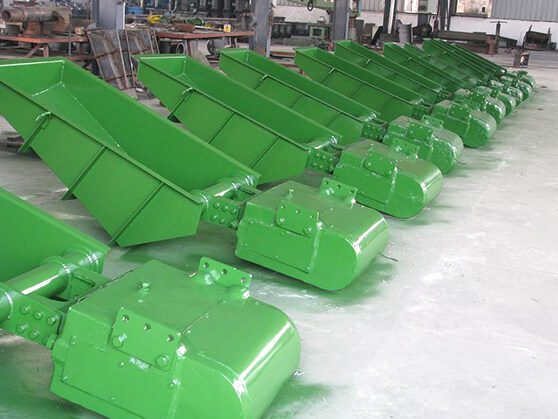مغذيات اهتزازية كهرومغناطيسية ضرورية لمناولة المواد بكفاءة في صناعات مثل التعدين ومعالجة الأغذية والأسمنت والمصانع الكيميائية. وسواء كنت بحاجة إلى نقل المواد الكاشطة أو المواد عالية الحرارة أو المواد المسببة للتآكل، فإن هذه المغذيات تضمن التشغيل الدقيق ومنخفض الصيانة بأقل استهلاك للطاقة. يغطي هذا الدليل فوائدها الرئيسية، والصيانة خطوة بخطوة، وطرق استكشاف الأعطال وإصلاحها التي أثبتت جدواها لزيادة الإنتاجية وتقليل وقت التعطل.
ما هو مبدأ عمل المغذي الاهتزازي الكهرومغناطيسي؟
يعمل المغذي الاهتزازي الكهرومغناطيسي من خلال اهتزازات نابضة محكومة يولدها نظام محرك كهرومغناطيسي. عند تنشيطه، يخلق المغناطيس الكهرومغناطيسي قوى جذب متناوبة تتسبب في تحرك الحوض إلى الخلف والأمام بسرعة (عادةً 50-60 دورة في الثانية). هذه الحركة، جنبًا إلى جنب مع النوابض ذات الزوايا الدقيقة، تخلق حركة رمي دقيقة تدفع المواد إلى الأمام في تدفق مستمر مع الحفاظ على التعامل اللطيف مع الحبيبات الهشة. يمكن ضبط معدل التغذية بدقة عن طريق تغيير مدخلات الجهد من خلال دائرة مقوم نصف الموجة.
لماذا تختار المغذي الاهتزازي الكهرومغناطيسي؟ 5 فوائد رئيسية
1. التحكم الآلي الذكي
يتميز بـ دائرة تصحيح نصف الموجة لـ تعديل التغذية بدون خطواتمثالية لخطوط الإنتاج المؤتمتة.
2. تصميم منخفض الصيانة
لا تحتاج إلى أجزاء دوارة أو تزييت - تقليل التعقيدات والتكاليف التشغيلية.
3. عمر افتراضي طويل مع الحد الأدنى من البلى
حركة الرمي الجزئي من المواد يقلل من تآكل الحوض بما يصل إلى 40% مقارنةً بالمغذيات اللولبية.
4. مقاومة التآكل ودرجات الحرارة العالية
حوض من سبائك الصلب يتعامل مع المواد حتى 200 درجة مئوية (392 درجة فهرنهايت) ويقاوم التآكل الكيميائي.
5. التشغيل الموفر للطاقة
يستهلك 30% أقل طاقة من المغذيات الميكانيكية، مع انبعاث ضوضاء منخفض (<75 ديسيبل).
علامات احتياج المغذي الاهتزازي للصيانة
انتبه لهذه العلامات التحذيرية:
🔧 اهتزازات أو ضوضاء غير عادية أو ضوضاء غير عادية
📉 تدفق المواد غير المتناسق (تغذية ناقصة/زائدة)
⚡ طفرات مفاجئة في استهلاك الطاقة
الصيانة الاستباقية تمنع 80% من الأعطال التشغيلية.
قائمة مراجعة صيانة وحدة التغذية الكهرومغناطيسية
1. عمليات التفتيش الأسبوعية
افحص السعة وتيار الملف (تشير الانحرافات >10% إلى وجود مشكلات).
استمع للضوضاء غير الطبيعية - قد تشير أصوات الطحن إلى وجود عطل في النابض أو البرغي.
2. تعديل فجوة الهواء (حاسم!)
- السبب: الخط المركزي للحوض وخط قوة الإثارة ليسا في نفس المستوى الرأسي.
- الحل: اضبطها لتكون في نفس المستوى الرأسي.
3. إحكام ربط الزنبرك والبراغي
تتسبب النوابض المفكوكة في حدوث اهتزازات التوائية - قم بإحكام ربطها كل 3 أشهر.
4. الوقاية من الغبار
قم بتنظيف غطاء الختم شهرياً لمنع انسداد الغبار في النوابض.

10 مشاكل شائعة في المغذي الاهتزازي (وكيفية إصلاحها بسرعة)
| المشكلة | السبب | الحل |
|---|---|---|
| لا يوجد اهتزاز بعد التشغيل | مصهر منفوخ أو ملف قصير | استبدل الصمام؛ افحص مقاومة السلك |
| تتدفق المواد بشكل جانبي | الحوض المنحرف وخط القوة المختل | إعادة توسيط الحوض الصغير عمودياً |
| اهتزاز ضعيف | تلف الثايرستور أو انسداد الفجوة | استبدل الثايرستور؛ قم بإزالة الحطام |
| ضوضاء عالية غير منتظمة | زنبرك مكسور/براغي مكسورة/براغي مفكوكة | استبدل النابض؛ أحكم ربط البراغي |
| تشغيل التيار العالي | فجوة الهواء كبيرة جدًا (> 2.5 مم) | اضبط الفجوة على 2 مم |
الأسئلة الشائعة - إجابات الخبراء
❓ كم مرة يجب أن أفحص وحدة التغذية الخاصة بي؟
أبجد هجدوز حطي كل من سعفص قرص قرشت ثاخذ ضظغغ
❓ هل يمكنها التعامل مع المواد الرطبة أو اللزجة؟
A: نعم، مع أحواض من الفولاذ المقاوم للصدأ وتصاميم مضادة للانسداد. [اتصل بنا للحصول على حلول مخصصة].
❓ ما هو متوسط العمر؟
A: 7-10 سنوات مع الصيانة المناسبة.
الخلاصة: تعظيم أداء وحدة التغذية
توفر المغذيات الاهتزازية الكهرومغناطيسية استخدامًا منخفضًا للطاقة، وأتمتة ذكية، ومتانة قوية للصناعات من الأغذية إلى التعدين. من خلال اتباع دليل الصيانة هذا ومعالجة المشكلات في وقت مبكر، يمكنك إطالة عمر المعدات بمقدار 30% وتجنب الأعطال المكلفة
إذا كانت لديك أي أسئلة أو كنت بحاجة إلى مزيد من الدعم، فلا تتردد في اتصل بنا. نتطلع إلى تزويدك بالخدمات والحلول الاحترافية!

